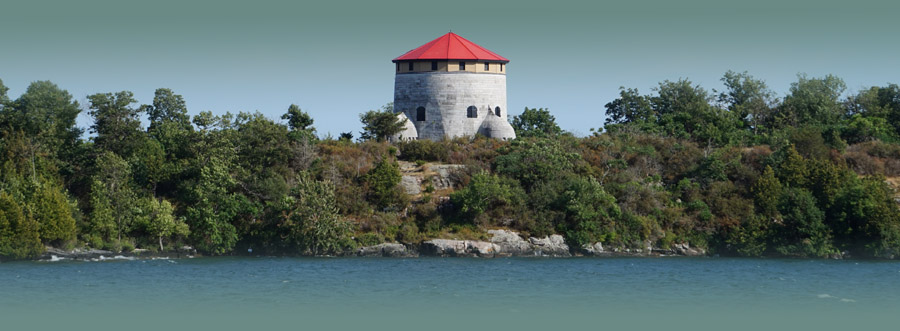 |
The Martello Tower
Wee starfort alternative |
 |
|
|
|
|
The Martello Tower is a tough, squatty little gun platform that was a relatively inexpensive alternative to a larger fortification. They were mostly built for coastal defense, and primarily constructed by Great Britain through much of the 19th century. Thanks to mid-19th century advancements in artillery, Martello Towers became obsolete not long after their heyday, but today something like 150 of them remain in 20 different countries spread 'cross the globe.
The Mediterranean island of Corsica was ruled by the Republic of Genoa in the 16th century. Barbary Pirates, a fearsome naval force of bloodthirsty North Africans, made frequent raids on villages on the Corsican coastline, nabbing folk and selling them into slavery. Beginning in 1530, the Genoese responded by building around 100 cannon-armed towers at strategic points along the Corsican coast.
Nearly all of these Genoese fortlets were low square towers, with a feature popular in medieval castles called machicoation: Holes in the upper level floors or open-bottomed boxes built at the outside top of the walls, through which unpleasant things could be poured and/or dropped onto attackers below.
This fortification program continued until 1620, when the many issues of maintaining and manning numerous far-flung outposts became overwhelming: The Genoese came to the conclusion that they wouldn't be able to effectively defend Corsica no matter how many cool little towers they built, so they threw up their hands, stopped building towers and invited the pirates to take whatever and whomever they wished.
While these gun towers may not have ultimately succeeded in their intended role of deterring 16th-century piracy, one of them, the Torre di Mortella on Corsica's northern coast near the Punta Mortella, proved more than a match for the Royal Navy in 1794. |
 |
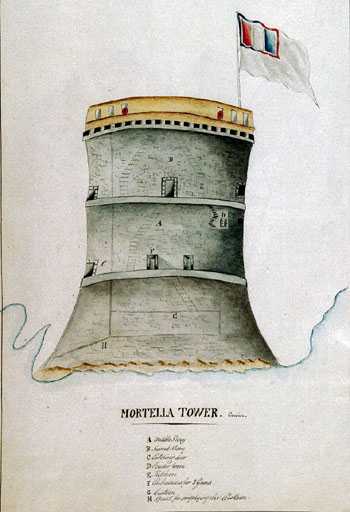 The prototype Martello Tower: The prototype Martello Tower:
Fratino's Torra di Mortella, c. 1794 |
|
|
|
 |
Much as Italians were responsible for the invention of the starfort, an Italian military engineer named Giovan Giacomo Paleari Fratino (1520-1586), known as "the Little Friar," designed the Torre di Mortella, which was the prototype for the Martello Tower. Fratino began his military career with the French, but was captured by the Spanish in 1558 during the Italian War of 1551-1559, after which he was apparently perfectly happy to join his previous enemies in the Spanish army. A good engineer is treasured by any army, and the Spanish loaned Fratini to the Genoese on Corsica in 1563. He did some work on several fortifications whilst there, including the stellar Citadelle d'Ajaccio. |
|
Fratini spent the year on Corsica, and after he returned to Spain he sent the Genoese the plans for an armed tower to be built near Punta Mortella, to protect the town of San Fiorenzo from seaborne nastiness. His tower was completed in October of 1565, a three-story cylindrical entity topped with a gun platform, which design thankfully dispensed with the medieval machicolation nonsense. There were no pirate raids on the town of San Fiorenzo that I can find, so it appears that the Torre di Mortella did its job.
|
|
Fast forward to 1794. Corsica is in French hands, and France is at war with Great Britain (for a change). Two Royal Naval vessels, the HMS Fortitude (a 74-gun, third-rate ship of the line) and the HMS Juno (a 32-gun, Amazon class fifth-rate), are ordered to reduce the offending Torre di Mortella to rubble. A 48-hour period of strenuous, violent effort ensued, during which time the 33 Frenchmen in the tower inflicted grievous damage to the Fortitude and Juno with heated shot, in the end falling only to a land attack.
|  |
 The HMS Fortitude, launched March 23, 1780 The HMS Fortitude, launched March 23, 1780 |
|
Britain's Royal Navy was no stranger to littoral combat, having had plenty of experience trading shots with shore batteries all around the world, but this tough little tower was something new under the sun (at least as far as the British were concerned), and quite impressive. So impressive, in fact, that careful notes were taken and drawings were made of the Torre di Mortella, whereupon it was destroyed, because why would the British leave a fortification that had proved to be such a worthy foe intact?
As the Torre di Mortella served as the prototype for all future Martello Towers, why aren't they called Mortella Towers? Most likely because the name was just misspelled somewhere along the way early in its development as a British fortification, but another interesting theory points out that the Italian word for "hammer" is martello...and each of the Genoese towers on Corsica was armed with a warning bell, which would be rung with...you guessed it...a martello.
|
|
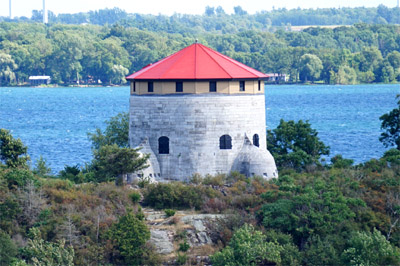 Cathcart Tower, one of five Martello Towers built to support Fort Henry in Kingston, Ontario. Kingston's Martellos are unusual in that they have bulbous caponnieres at their base, which acted like little bastions! Cathcart Tower, one of five Martello Towers built to support Fort Henry in Kingston, Ontario. Kingston's Martellos are unusual in that they have bulbous caponnieres at their base, which acted like little bastions! |
 |
England's acceptance of the Martello Tower as a viable coastal fortification at the start of the 19th century came at an opportune moment. While Britain had been at war with France off and on for the preceding thirteen thousand years or so, there hadn't been a serious threat of invasion since the days of the Spanish Armada in the 16th century. Napoleon's control of virtually all of Europe, however, made it seem as though it was just a matter of time before the Tiny Tyrant came across the English Channel in force. Defending the shores of the British Isles was suddenly paramount, and the Martello Tower was an excitingly new, inexpensive and relatively speedy solution.
The standard design of a British Martello Tower was a two-story, 40-foot-high cylindrical tower, sometimes with a basement level beneath. The top of the tower had a single cannon, which could be traversed 360° for a full range of fire. The tower had masonry walls with a thickness of about eight feet, but its thickness was often greater on the side facing the sea. |
|
Access to the tower was granted by a ladder about ten feet from the ground, above which was a slotted base through which fire could be directed at a climbing enemy (machicolation strikes again). The tower's walls were studded with loopholes for defensive musket fire. A Martello Tower was designed to be a self-sustaining fort. Its basement stored food and water (a well or sistern usually supplied that water), and its ground level stored powder and supplies. Around 24 men and an officer or two lived on the second floor (or first level if you're European) in separate quarters, with fireplaces built into the walls for heat and cooking.
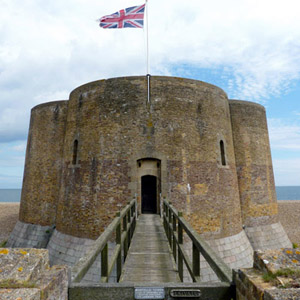 Aldeburgh Tower in Suffolk, on Britain's eastern coast. It is a unique quatrefoil design, like four towers smooshed into one, with mounts for four guns atop. Aldeburgh Tower in Suffolk, on Britain's eastern coast. It is a unique quatrefoil design, like four towers smooshed into one, with mounts for four guns atop. |
 |
While all Martello Towers are generally similar, there was no universally-recognized "standard design." Like starforts, Martello Towers were built in a variety of styles, out of the materials at hand, with an eye to local conditions. British Army Royal Engineer General William Twiss (1745-1827) oversaw the construction of Britain's Martello Tower network, but like the father of the Starfort, Vauban, he clearly felt that there was no need for uniformity of design. Building efforts at the start of the 19th century were local in nature, and it's unlikely that there could have been design uniformity even had it been desired.
|
|
 |
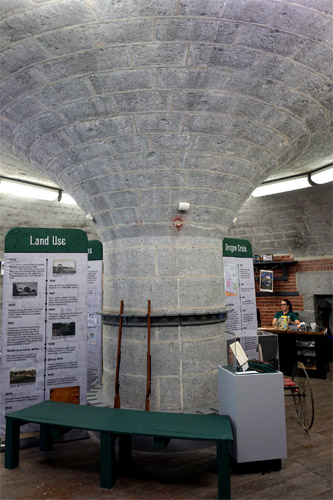 Putting the heaviest object imaginable on the very top of a slim fortification necessitated drastic (and artistic) measures beneath, as evidenced in Murnay Redoubt's second level, in Kingston, Ontario. Putting the heaviest object imaginable on the very top of a slim fortification necessitated drastic (and artistic) measures beneath, as evidenced in Murnay Redoubt's second level, in Kingston, Ontario. |
|
Great Britain built most of its Martello Towers at home: A total of 103 were built along England's south and eastern coasts, as well as the eastern coat of Ireland, between 1804 and 1812. These were for the specific purpose of defending England from Napoleon's much-desired (by Napoleon) but non-existant invasion fleet, and was the only instance in which large numbers of Martello Towers were built in a defensive array. England built plenty more of them around the world, but for the most part individually, as redoubts to defend specific locations.
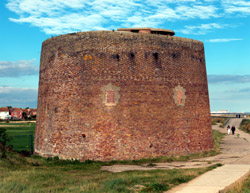 Martello Tower D, Martello Tower D,
Clacton-on-Sea, Essex |
 |
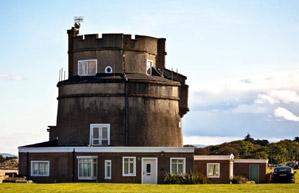 Portmarnock Tower, Portmarnock Tower,
Dublin, Ireland |
 |
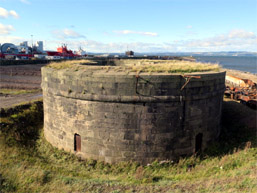 Tally To'or, Tally To'or,
Edinburgh, Scotland |
Martello Towers were built in nearly 20 other places around the world, mostly at the behest of the British. Between 1796 and 1860, Great Britain built over 230 Martello Towers worldwide. Outside of the UK, Canada was the most heavily Martello'd nation with a total of sixteen. The city of Kingston, Ontario was the beneficiary of no fewer than five Martello Towers, built in the 1840's to support Fort Henry. The fort's two "branch towers" are unusual in that they are much taller than one's everyday Martello Tower. Fort Mississauga, built to fill the gap when the dastardly Americans captured Fort George on the Canadian side of the Niagara River during the War of 1812, is generally considered to be a Martello Tower, though its square design within a complex of earthwork walls technically makes it a keep.
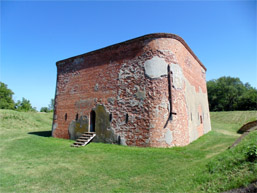 Fort Mississauga, Fort Mississauga,
Niagara-on-the-Lake, Ontario |
 |
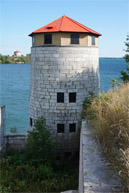 East Branch Tower, East Branch Tower,
Kingston, Ontario |
 |
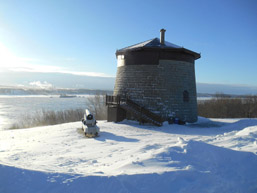 Tower No. 1, Tower No. 1,
Québec City, Québec |
|
 |
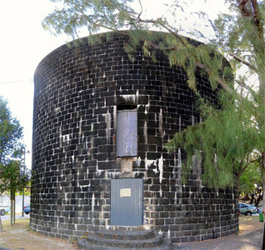 |
 |
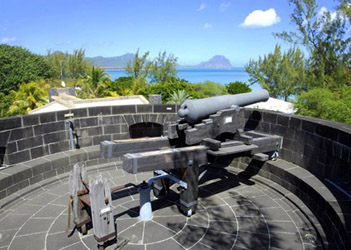 |
 |
Great Britain wrested the Indian Ocean island of Mauritius from France in 1810, and the island's new owners swiftly fortified it with six Martello Towers. Sadly, only La Preneuse Tower (left), built 1832- 1835, still remains in place today.
Britain built Martello Towers to protect many of the far-flung places in which it had interest in the early-to-mid 19th century: Australia, Bermuda, Croatia, Jamaica, Malta, Sicily, South Africa and the Virgin Islands were all blessed with a British Martello Tower or two.
|
|
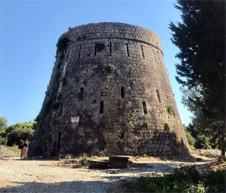 Fort Wellington (Forteca Korčula), Fort Wellington (Forteca Korčula),
Korčula, Croatia |
 |
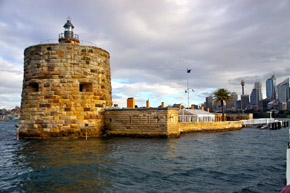 Fort Denison, Fort Denison,
Sydney, Australia |
 |
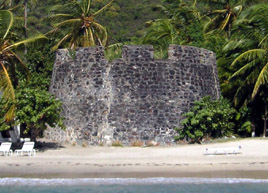 Fort Recovery, Fort Recovery,
Tortola, British Virgin Islands |
|
The United States wasn't a British possession by the time Martello Towers were being built in numbers, but six of the things managed to appear on America's eastern and gulf coasts anyway. Most of them, like Walbach Tower at Portsmouth, New Hampshire (built to protect an exposed flank of Fort Constitution) and on Tybee Island, Georgia (later to be eclipsed by Fort Pulaski) were of the standard cylindrical design, but Forts East and West Martello on Key West, Florida, were square towers behind masonry walls. Of those Martello Towers built on American soil, only Fort East Martello remains intact today...serving the local community as a delightful museum dedicated to both Key West and extremely weird artwork.
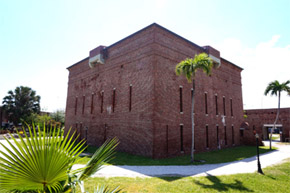 Fort East Martello, Fort East Martello,
Key West, Florida |
 |
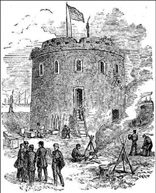 Tybee Tower, Tybee Tower,
Tybee Island, Georgia |
 |
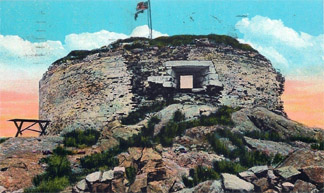 Walbach Tower, Walbach Tower,
Newcastle, New Hampshire |
|
|
Martello Towers were so rare and abandoned so comprehensively in the United States that frequently, nobody knew what they were in later years. They seemed so foreign that they were sometimes credited to the Spanish, as was the case with Tower Dupre, built (probably) in the 1830's near Bayou Dupre's entrance to Lake Borgne, just outside New Orleans, likely during the same spasm of American defensive fortification for that city that brought us Fort Pike and Fort Macomb. |
 |
|
India's Hanumant Bastion is of Portuguese construction, and dates to the 1530's. It sure looks like a Martello Tower, and may have more or less funtioned as one, but it has a lot in common with the bastions of Arnala Fort, just a bit to the north on Arnala Island, off of India's western coast...and as it was built around the same time that the Genoese were dotting Corsica's coast with the little square towers that started this whole Martello Tower thing, it seems likely that this was just a fortified sentry tower of a sort. There appears to be no internationally recognized Martello Tower authority, so who decides if this counts as a Martello Tower or not?
Of similar dubious Martello Tower authenticity is the Torre della Linguella, an Italian tower on the island of Elba. This tower was also built in the early 16th century, and shares more history with the invention of the starfort than the Martello Tower. |
 |
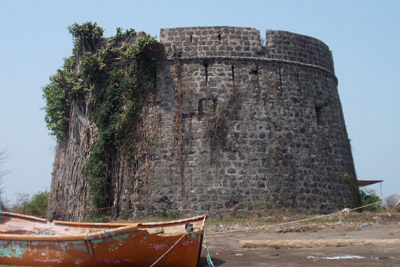 Hanumant Bastion: Armana Island, India Hanumant Bastion: Armana Island, India |
|
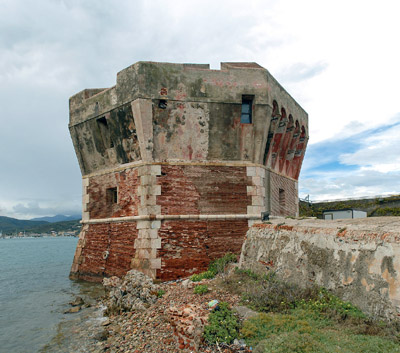 Torre della Linguella, Elba, Italy Torre della Linguella, Elba, Italy |
 |
Prior to Elba's attainment of international fame as the place where Napoleon (1769-1821) was sent into exile the first time (1814-1815), it was owned by the insanely influential Medici family. Much as the Medici contracted the hippest and most forward-thinking military engineers to develop a new style of fortification to protect their properties in northern Italy from the wicked French and their dastardly artillery at the tail end of the 15th century (which was the genesis of the starfort), they also ordered the construction of a tower to protect the port of Portoferraio on Elba.
From what I can tell this tower was used for sighting more than anything else, but also operated as a warehouse and a prison through the years...no artillery was mounted atop, so I suppose it is no Martello Tower.
The Martello Towers that remain on this earth serve a variety of functions: Museums, hotels and private residences, but those that are unrestored continue to crumble away, enticing and dangerous curiosities for intrepid visitors. |
|
Though there were examples built by (a very few) other nations, ultimately the Martello Tower was a British phenomenon. I have not been charitable to the Martello Tower concept at this site, uninformedly viewing them as a cheap 'n' dumb alternative to an actual starfort...but my experience with the Martello Towers of Kingston, Ontario in 2019 opened my eyes. They existed not as replacements for starforts, but often as enhancements to an existing fortification's firepower. When they stood alone, the noble Martello Tower provided a solid defense that gave any potential attacker pause. Did Napoleon not cross the English Channel because he wasn't able to get his ampihibious act together, or because he was secretly terrified of the hundreds of Martello Towers arrayed against such an endeavor? Whichever, but he didn't, so we can pretend that was thanks to Martello Towers if we wish.
|
|
|
|
Should you find your appetite for Martello Tower information unsatisfied, might I direct you to what looks to be the Internet's definitive chronicle on the subject, Martellotowers.co.uk. Wikipedia's Martello Tower page is of course a fount of information, and includes a map of Martello Tower locations around the globe. Starforts.com's pages about Fort Frederick in Kingston and the Fortifications of Cork are also at least nominally about Martello Towers. |
|
|
|


